Of all the many towns and villages that we've visited in the land of the
Pharos, Luxor, the former capital of ancient Egypt, qualifies as my favorite. An even
weighing of bias for both its sights and its people, put it on the top of the list.
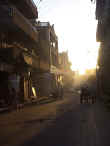 Even though this Nile-side town has grown up
around the tourist industry, it still retains every aspect of a traditional Egyptian
community, as well as hints of its ancient splendor. The name Luxor comes from the Arabic
word ‘El-Uqsor’, which means palaces. This moniker refers to the palaces of the
gods, better known in today’s terminology as temples. In this case, the name fits
well. Luxor lays claim to many of the most impressive of Egypt’s ancient monuments.
Even though this Nile-side town has grown up
around the tourist industry, it still retains every aspect of a traditional Egyptian
community, as well as hints of its ancient splendor. The name Luxor comes from the Arabic
word ‘El-Uqsor’, which means palaces. This moniker refers to the palaces of the
gods, better known in today’s terminology as temples. In this case, the name fits
well. Luxor lays claim to many of the most impressive of Egypt’s ancient monuments.
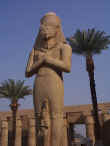 It is
in the city itself that two of these wonders sit almost side-by-side. Our day of
sightseeing began at the sprawling complex which groups several temples within its far
reaching walls - the hugely impressive complex of Karnak. Over the centuries, it grew to
its present vast proportions, as each dynasty added its own temple, monument, or shrine to
the existing series of structures. Each king, in each dynasty, would, of course, do his
best to outdo the others before him.
It is
in the city itself that two of these wonders sit almost side-by-side. Our day of
sightseeing began at the sprawling complex which groups several temples within its far
reaching walls - the hugely impressive complex of Karnak. Over the centuries, it grew to
its present vast proportions, as each dynasty added its own temple, monument, or shrine to
the existing series of structures. Each king, in each dynasty, would, of course, do his
best to outdo the others before him.
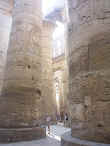 Just a few of the most impressive, of the most impressive include: the
Great Hypostyle Hall, with its 134 giant columns arraigned in 16 rows. These massive stone
structures are each 70 feet high and 45 feet in circumference (50 people could stand on
top of each one). The columns show the Egyptians sophisticated religious practices with
carvings of their kings making offerings to the gods, as the ruins of the massive ceiling
show their sophistication in the science of architecture.
Just a few of the most impressive, of the most impressive include: the
Great Hypostyle Hall, with its 134 giant columns arraigned in 16 rows. These massive stone
structures are each 70 feet high and 45 feet in circumference (50 people could stand on
top of each one). The columns show the Egyptians sophisticated religious practices with
carvings of their kings making offerings to the gods, as the ruins of the massive ceiling
show their sophistication in the science of architecture.
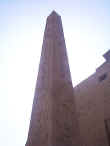 The
hall is the largest temple supported by columns in the world. It is so large that it could
easily contain the whole of Notre Dame de Paris within its walls. In addition, just beyond
this great hall are the obeliscs of Tutmose I and a smaller, but still colossal banqueting
hall, the sacred lake, and numerous other rooms and halls.
The
hall is the largest temple supported by columns in the world. It is so large that it could
easily contain the whole of Notre Dame de Paris within its walls. In addition, just beyond
this great hall are the obeliscs of Tutmose I and a smaller, but still colossal banqueting
hall, the sacred lake, and numerous other rooms and halls.
Our second stop of the day was the great sanctuary dedicated to the creator god Amun
(yes, some say, as in Amen).
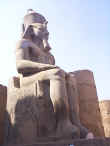 The
avenue leading to the entrance of this temple is lined with human headed sphinxes. This
same avenue once connected this with the Karnak complex. The outer gate is guarded with
twin statues of Ramses II, while the inner chambers pay tribute to the Amenophis III.
Smack dab in the middle of the temple is a mosque. Sitting about 25 feet above what is now
(after excavation) ground level, this relatively modern Islamic cathedral seems to float
in space above the dusty ruins of the early Egyptians.
The
avenue leading to the entrance of this temple is lined with human headed sphinxes. This
same avenue once connected this with the Karnak complex. The outer gate is guarded with
twin statues of Ramses II, while the inner chambers pay tribute to the Amenophis III.
Smack dab in the middle of the temple is a mosque. Sitting about 25 feet above what is now
(after excavation) ground level, this relatively modern Islamic cathedral seems to float
in space above the dusty ruins of the early Egyptians.
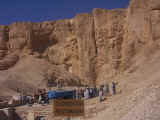 Across
the river and into the desert, lays the Valley of the Kings and Valley of the Queens. To
date, archeologists have discovered over seventy tombs in this unimposing gorge of rocky
ravines known as Valley of the Kings. King Tutmose I was the first to break a long
tradition of grandiose (and very obvious) burial grounds by having his eternal (or at
least that was the idea) resting place dug deep into an inconspicuous crack, in an
isolated valley. Unfortunately his, nor the efforts of the 80 or so successive pharaohs,
succeeded in foiling the industrious grave robbers of the time.
Across
the river and into the desert, lays the Valley of the Kings and Valley of the Queens. To
date, archeologists have discovered over seventy tombs in this unimposing gorge of rocky
ravines known as Valley of the Kings. King Tutmose I was the first to break a long
tradition of grandiose (and very obvious) burial grounds by having his eternal (or at
least that was the idea) resting place dug deep into an inconspicuous crack, in an
isolated valley. Unfortunately his, nor the efforts of the 80 or so successive pharaohs,
succeeded in foiling the industrious grave robbers of the time.
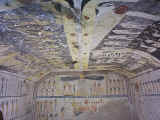 Now, thousands of years later, all that remains are the tombs themselves,
adorned with vividly carved and brightly painted scenes of the everyday yester-world, as
well as scenes of the many pomp religious rituals. In spite of the efforts of the grave
robbers, and thanks for the most part to the dry desert climate, these are all
astonishingly well preserved considering how long ago they were carved and painted.
Now, thousands of years later, all that remains are the tombs themselves,
adorned with vividly carved and brightly painted scenes of the everyday yester-world, as
well as scenes of the many pomp religious rituals. In spite of the efforts of the grave
robbers, and thanks for the most part to the dry desert climate, these are all
astonishingly well preserved considering how long ago they were carved and painted.
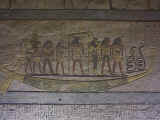 We took the time to explore the tombs of Sa-Ptah, Ramsey IX, Tuthmosis
III. In much the same fashion, the Queens of the time also claimed a valley to dig their
burial chambers. We walked down the long, sloping corridors of the tombs of Queen Titi,
Queen Amunherkhupshep, and finally, that of Queen Kha-em Wast.
We took the time to explore the tombs of Sa-Ptah, Ramsey IX, Tuthmosis
III. In much the same fashion, the Queens of the time also claimed a valley to dig their
burial chambers. We walked down the long, sloping corridors of the tombs of Queen Titi,
Queen Amunherkhupshep, and finally, that of Queen Kha-em Wast.
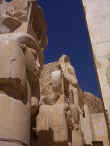 The highlight of our trip into the valley was most definitely our 15
minute (time in the tomb was strictly limited) walk into around the Queen of Nefertari.
Her tomb has been renovated by a team of Italian archeologists. Although they only
restored, not touched up or repainted, the walls, they were nearly back to their original
striking vibrancy. Nothing short of breathtaking.
The highlight of our trip into the valley was most definitely our 15
minute (time in the tomb was strictly limited) walk into around the Queen of Nefertari.
Her tomb has been renovated by a team of Italian archeologists. Although they only
restored, not touched up or repainted, the walls, they were nearly back to their original
striking vibrancy. Nothing short of breathtaking.
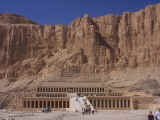 A short drive away from the Valley of the Queens is Queen
Hatshepsut’s Temple. Famous for breaking all the rules and making herself a pharaoh,
she chose a spectacular site to build her mortuary temple. The three colonnaded terraces
are cut into the hillside. Originally capped with a huge pyramid covered in gold, when
basking in the light of the bright African sun, the entire complex must have been duly
impressive to both friends and enemies alike.
A short drive away from the Valley of the Queens is Queen
Hatshepsut’s Temple. Famous for breaking all the rules and making herself a pharaoh,
she chose a spectacular site to build her mortuary temple. The three colonnaded terraces
are cut into the hillside. Originally capped with a huge pyramid covered in gold, when
basking in the light of the bright African sun, the entire complex must have been duly
impressive to both friends and enemies alike.



